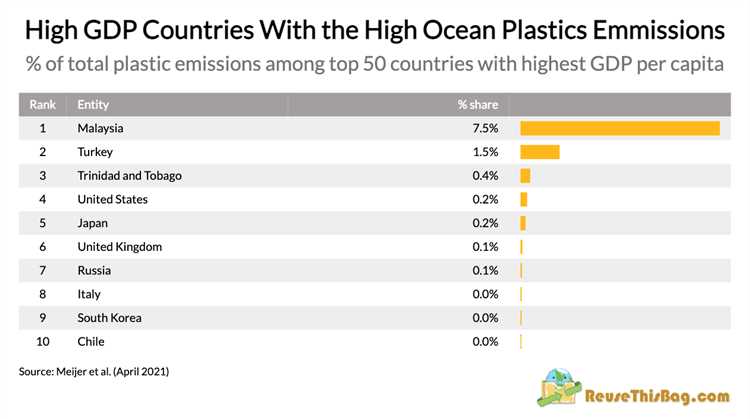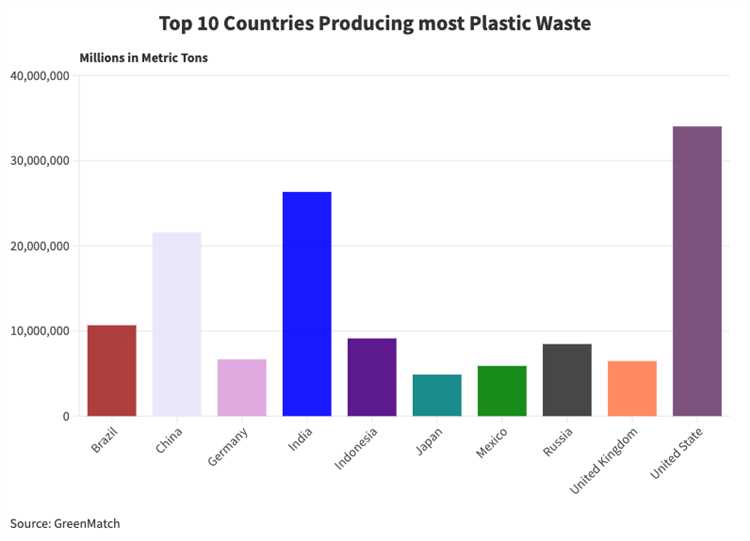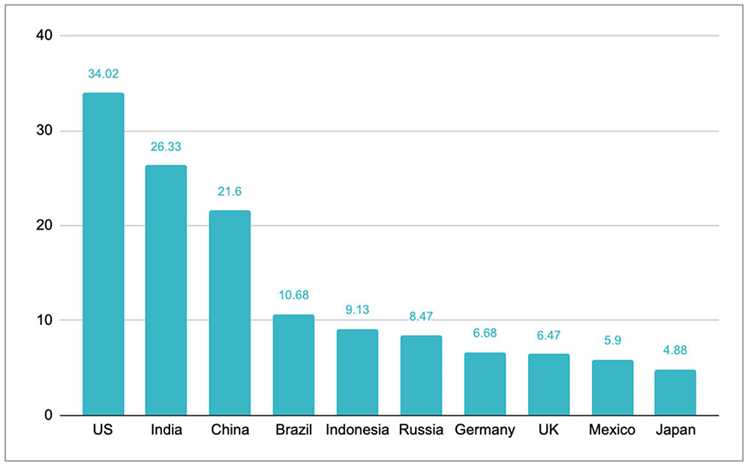
In today’s world, the issue of plastic waste has become a global concern. The massive production and consumption of plastic products have led to devastating effects on the environment, particularly our oceans and marine life. But which country can be held responsible for the highest level of plastic waste?
It may come as no surprise that China, with its enormous population and rapid urbanization, has held this unfortunate title for many years. China’s booming economy and industrial growth have resulted in an alarming increase in plastic waste production. The country has struggled to manage its waste effectively, leading to massive amounts of plastic ending up in landfills, rivers, and oceans.
However, recent reports and studies indicate that another country has surpassed China in terms of plastic waste production. The United States has now become the largest generator of plastic waste globally. With its high consumerism and disposable lifestyle, the United States has faced significant challenges in dealing with the sheer volume of plastic waste it generates.
Plastic pollution poses a severe threat to our ecosystems, wildlife, and human health. It is crucial for countries worldwide to address this issue urgently and implement sustainable solutions to reduce, reuse, and recycle plastic waste. Only by working together can we hope to mitigate this global crisis and protect our planet for future generations.
- The Country with the Most Plastic Waste
- Factors Contributing to the Plastic Waste Problem
- Inadequate Waste Management Systems
- Single-Use Plastic Items
- Assessing the Plastic Levels in Different Countries
- Contenders for the Title of the Highest Plastic Waste
- 1. United States
- 2. China
- 3. Indonesia
- The Country with the Highest Level of Plastic Waste
- The Scale of the Problem
- The Environmental Impact
- Q&A
- Which country is responsible for the most plastic waste?
- What are some countries that contribute heavily to plastic pollution?
- Why is China responsible for such a high level of plastic waste?
- What are the environmental impacts of high levels of plastic waste?
The Country with the Most Plastic Waste
Plastic waste has become a global problem, with countries around the world struggling to manage its accumulation and disposal. However, there is one country that holds the title for the highest level of plastic waste: China.
China, a country known for its rapid economic growth and large population, also produces a significant amount of plastic waste. With its extensive manufacturing industry and consumption habits, China generates about 30% of the world’s total plastic waste.
There are several reasons why China has become the top contributor to plastic waste. First, the country’s plastic production has skyrocketed in recent decades, driven by the demand for cheap and easily accessible goods. This rapid increase in plastic production has led to a corresponding increase in plastic waste.
In addition, China’s recycling infrastructure has struggled to keep up with the rising amount of plastic waste. While there are efforts to improve recycling rates, many plastic items are still not recycled properly and end up polluting the environment.
Furthermore, China has also been a major contributor to the global plastic waste crisis due to its exports. The country has been a significant exporter of plastic waste to other countries, exacerbating the issue on a global scale.
| Country | Plastic Waste (in million metric tons) |
|---|---|
| China | Approximately 59 |
| Indonesia | Approximately 16 |
| Philippines | Approximately 16 |
| Vietnam | Approximately 10 |
| Sri Lanka | Approximately 5 |
Despite these challenges, China has recently taken steps to address its plastic waste problem. The country has implemented various policies to reduce plastic consumption and improve recycling rates. Additionally, there are ongoing efforts to develop alternative materials that are more sustainable and biodegradable.
It is clear that plastic waste is a pressing issue that requires global cooperation and solutions. While China holds the title for the highest level of plastic waste, it also has the potential to lead the way in finding innovative and sustainable solutions to this problem.
Factors Contributing to the Plastic Waste Problem
Plastic waste has become a global environmental crisis, and there are several key factors that contribute to this pressing issue.
Inadequate Waste Management Systems

One of the primary factors contributing to the plastic waste problem is the lack of effective waste management systems in many countries. Inadequate waste collection, recycling, and disposal facilities mean that a significant amount of plastic waste ends up in landfills, rivers, and oceans.
Single-Use Plastic Items
The proliferation of single-use plastic items has also contributed to the mounting plastic waste problem. The convenience and affordability of products like plastic bags, bottles, and packaging have led to a rise in their production and consumption, resulting in excessive plastic waste generation.
Lack of Recycling Infrastructure
Another critical factor is the lack of proper recycling infrastructure. While recycling offers a solution to reduce plastic waste, many countries lack the necessary facilities and resources to effectively manage and process recyclable plastics. This results in a reduced recycling rate and more plastic waste being sent to landfills or becoming litter.
Consumer Behavior and Attitudes
Consumer behavior and attitudes also play a significant role in the plastic waste problem. The increased demand for convenience and the culture of disposability have contributed to the widespread use of single-use plastics. Additionally, lack of awareness about the environmental impact of plastic waste and a general lack of concern about its consequences further exacerbate the problem.
It is crucial for governments, businesses, and individuals to address these factors and take proactive measures to reduce plastic waste. Implementing effective waste management systems, promoting alternatives to single-use plastics, investing in recycling infrastructure, and raising awareness about the importance of responsible consumption and disposal can all help in mitigating the plastic waste problem.
Assessing the Plastic Levels in Different Countries
When it comes to plastic waste, it is crucial to assess the levels in different countries to identify the extent of the problem and find potential solutions. Understanding the amount of plastic waste generated by each country allows policymakers, environmental organizations, and individuals to develop effective strategies for reducing plastic consumption and improving waste management.
One way to assess plastic levels is by looking at the total amount of plastic waste generated per capita. This metric provides insights into the average plastic consumption of individuals in a particular country. By comparing this data across different countries, we can identify which countries have the highest levels of plastic waste.
Another important factor to consider is plastic recycling rates. This metric measures the percentage of plastic waste that is recycled rather than ending up in landfills or the environment. It provides valuable information about a country’s waste management infrastructure and the effectiveness of recycling programs. A higher recycling rate indicates a more sustainable approach to plastic waste management.
Additionally, assessing the type and source of plastic waste is crucial. Plastic waste can come from various sources, including packaging, single-use items, and industrial processes. By understanding the primary sources of plastic waste in different countries, targeted interventions can be developed to reduce plastic consumption and promote alternatives.
Creating a comprehensive assessment of plastic levels requires data collection and analysis. National governments, research institutions, and international organizations play a vital role in gathering and reporting accurate data on plastic waste. This data should be updated regularly to reflect the current situation and enable timely interventions.
| Country | Plastic Waste per Capita (kg/year) | Plastic Recycling Rate (%) | Primary Sources of Plastic Waste |
|---|---|---|---|
| Country A | 100 | 30 | Packaging, single-use items |
| Country B | 150 | 40 | Industrial processes, packaging |
| Country C | 200 | 20 | Single-use items, packaging |
As illustrated in the table above, different countries have varying levels of plastic waste per capita and recycling rates. This information highlights areas where improvements can be made and provides a basis for benchmarking progress over time.
Assessing the plastic levels in different countries is a crucial step towards addressing the global issue of plastic waste. By identifying the countries with the highest levels of plastic waste and understanding the factors contributing to these levels, stakeholders can collaborate to develop effective strategies for reducing plastic consumption, improving waste management, and preserving the environment for future generations.
Contenders for the Title of the Highest Plastic Waste

Plastic waste is a global environmental issue that affects countries all over the world. While many countries are making efforts to reduce their plastic waste, there are several contenders for the title of the highest plastic waste. These countries are facing significant challenges in managing and reducing their plastic waste levels.
1. United States
The United States is one of the largest producers of plastic waste in the world. With a population of over 300 million and a high standard of living, it’s no surprise that the country generates a massive amount of plastic waste. Despite efforts to recycle and reduce plastic consumption, much of the plastic ends up in landfills or polluting the environment.
2. China
As the most populous country in the world, China has a huge amount of plastic waste to manage. Rapid economic growth and urbanization have led to increased consumption and production of plastic products. China has made progress in recycling and waste management, but there is still a long way to go in addressing the high level of plastic waste.
3. Indonesia
Indonesia is the world’s second-largest contributor to plastic waste in the oceans. With a population of over 270 million people spread across thousands of islands, managing plastic waste is a significant challenge. Limited waste management infrastructure and a lack of awareness about the environmental impact of plastic contribute to Indonesia’s high plastic waste levels.
These countries are just a few examples of the contenders for the title of the highest plastic waste. It is vital for governments and individuals worldwide to prioritize plastic waste reduction and implement effective waste management strategies to combat this global issue.
The Country with the Highest Level of Plastic Waste
The Scale of the Problem
China is the world’s most populous country, with over 1.4 billion people. Its huge population and rapid economic growth over the past few decades have led to a massive increase in plastic consumption and subsequently plastic waste generation. The country produces an estimated 60 million tons of plastic waste annually, which is more than the next four highest plastic waste generating countries combined.
China’s plastic waste crisis is not limited to its domestic consumption. The country is also the world’s largest importer of plastic waste, taking in tons of plastic scrap from other countries. This has led to significant environmental and health problems, as much of the imported plastic waste is improperly managed and ends up in rivers, landfills, or is burned, releasing toxic pollutants into the air.
The Environmental Impact
The high level of plastic waste in China has severe consequences for the environment. Plastics take hundreds of years to decompose, and during this time, they release harmful chemicals and microplastics that pollute waterways and soil. Marine life is particularly affected, with millions of marine animals dying each year from ingesting or getting entangled in plastic waste.
The polluted rivers and soil have a negative impact on agriculture, as plastics can contaminate crops and reduce the fertility of the land. The burning of plastic waste also contributes to air pollution, leading to respiratory problems and other health issues for local populations.
Aware of the problem, the Chinese government has taken steps to address the plastic waste crisis. They have implemented stricter regulations on plastic waste imports, banned the use of certain single-use plastics, and promoted recycling initiatives. However, the scale of the problem means that more efforts are required to tackle the issue effectively.
In conclusion, China currently holds the title for the highest level of plastic waste. The country’s massive population and high plastic consumption have resulted in millions of tons of plastic waste being generated each year. This has had devastating environmental consequences and poses significant challenges for Chinese authorities. However, it is crucial that all countries work together to reduce plastic waste and find sustainable solutions for plastic management to protect our planet for future generations.
Q&A
Which country is responsible for the most plastic waste?
The country that holds the title for the highest level of plastic waste is China. According to a report by the Ocean Conservancy and the McKinsey Center for Business and Environment, China is responsible for 2.9 million metric tons of plastic waste. This is followed by Indonesia, the Philippines, Vietnam, and Sri Lanka.
What are some countries that contribute heavily to plastic pollution?
Several countries contribute heavily to plastic pollution. China is at the top of the list, followed by Indonesia, the Philippines, Vietnam, and Sri Lanka. These countries generate a significant amount of plastic waste, which often ends up in the ocean due to inadequate waste management systems.
Why is China responsible for such a high level of plastic waste?
China is responsible for a high level of plastic waste due to several factors. Firstly, it has a large population, which leads to a higher consumption of plastic products. Secondly, China has experienced rapid economic growth, resulting in increased industrialization and urbanization. This has led to a rise in the production and consumption of plastic products. Additionally, China has faced challenges in developing an effective waste management system, which contributes to the amount of plastic waste generated.
What are the environmental impacts of high levels of plastic waste?
High levels of plastic waste have significant environmental impacts. Plastic waste often ends up in the ocean, where it harms marine life and ecosystems. Animals can become entangled in plastic debris or mistake it for food, leading to injury or death. Plastic waste also contributes to the pollution of waterways and soil, as it takes hundreds of years to decompose. Additionally, the production of plastic requires the extraction of fossil fuels, contributing to greenhouse gas emissions and climate change.